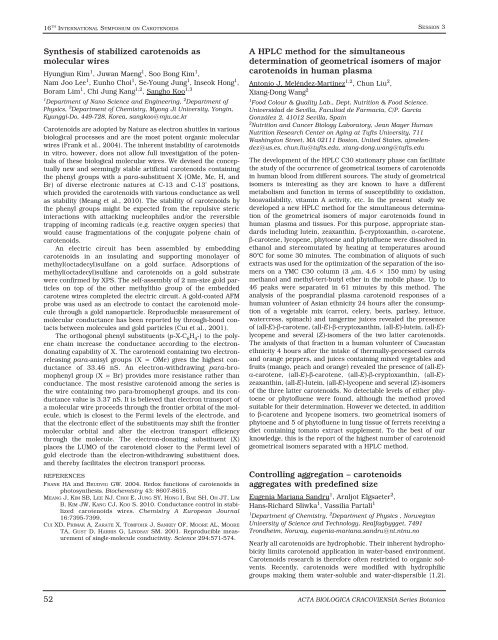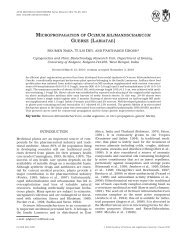ACTA BIOLOGICA CRACOVIENSIA
ACTA BIOLOGICA CRACOVIENSIA
ACTA BIOLOGICA CRACOVIENSIA
Create successful ePaper yourself
Turn your PDF publications into a flip-book with our unique Google optimized e-Paper software.
16 TH INTERNATIONAL SYMPOSIUM ON CAROTENOIDS<br />
Synthesis of stabilized carotenoids as<br />
molecular wires<br />
Hyungjun Kim1 , Juwan Maeng1 , Soo Bong Kim1 ,<br />
Nam Joo Lee 1 , Eunho Choi1 , Se-Young Jung1 , Inseok Hong1 ,<br />
Boram Lim 1 , Chi Jung Kang1,2 , Sangho Koo1,3 1 Department of Nano Science and Engineering, 2 Department of<br />
Physics, 3 Department of Chemistry, Myong Ji University, Yongin,<br />
Kyunggi-Do, 449-728, Korea, sangkoo@mju.ac.kr<br />
Carotenoids are adopted by Nature as electron shuttles in various<br />
biological processes and are the most potent organic molecular<br />
wires (Frank et al., 2004). The inherent instability of carotenoids<br />
in vitro, however, does not allow full investigation of the potentials<br />
of these biological molecular wires. We devised the conceptually<br />
new and seemingly stable artificial carotenoids containing<br />
the phenyl groups with a para-substituent X (OMe, Me, H, and<br />
Br) of diverse electronic natures at C-13 and C-13’ positions,<br />
which provided the carotenoids with various conductance as well<br />
as stability (Meang et al., 2010). The stability of carotenoids by<br />
the phenyl groups might be expected from the repulsive steric<br />
interactions with attacking nucleophiles and/or the reversible<br />
trapping of incoming radicals (e.g. reactive oxygen species) that<br />
would cause fragmentations of the conjugate polyene chain of<br />
carotenoids.<br />
An electric circuit has been assembled by embedding<br />
carotenoids in an insulating and supporting monolayer of<br />
methyl(octadecyl)sulfane on a gold surface. Adsorptions of<br />
methyl(octadecyl)sulfane and carotenoids on a gold substrate<br />
were confirmed by XPS. The self-assembly of 2 nm-size gold particles<br />
on top of the other methylthio group of the embedded<br />
carotene wires completed the electric circuit. A gold-coated AFM<br />
probe was used as an electrode to contact the carotenoid molecule<br />
through a gold nanoparticle. Reproducible measurement of<br />
molecular conductance has been reported by through-bond contacts<br />
between molecules and gold particles (Cui et al., 2001).<br />
The orthogonal phenyl substituents (p-X-C 6 H 4 -) to the polyene<br />
chain increase the conductance according to the electrondonating<br />
capability of X. The carotenoid containing two electronreleasing<br />
para-anisyl groups (X = OMe) gives the highest conductance<br />
of 33.46 nS. An electron-withdrawing para-bromophenyl<br />
group (X = Br) provides more resistance rather than<br />
conductance. The most resistive carotenoid among the series is<br />
the wire containing two para-bromophenyl groups, and its conductance<br />
value is 3.37 nS. It is believed that electron transport of<br />
a molecular wire proceeds through the frontier orbital of the molecule,<br />
which is closest to the Fermi levels of the electrode, and<br />
that the electronic effect of the substituents may shift the frontier<br />
molecular orbital and alter the electron transport efficiency<br />
through the molecule. The electron-donating substituent (X)<br />
places the LUMO of the carotenoid closer to the Fermi level of<br />
gold electrode than the electron-withdrawing substituent does,<br />
and thereby facilitates the electron transport process.<br />
REFERENCES<br />
FRANK HA and BRUDVIG GW. 2004. Redox functions of carotenoids in<br />
photosynthesis. Biochemistry 43: 8607-8615.<br />
MEANG J, KIM SB, LEE NJ. CHOI E, JUNG SY, HONG I, BAE SH, OH JT, LIM<br />
B, KIM JW, KANG CJ, KOO S. 2010. Conductance control in stabilized<br />
carotenoids wires. Chemistry A European Journal<br />
16:7395-7399.<br />
CUI XD, PRIMAK A, ZARATE X, TOMFOHR J, SANKEY OF, MOORE AL, MOORE<br />
TA, GUST D, HARRIS G, LINDSAY SM. 2001. Reproducible measurement<br />
of single-molecule conductivity. Science 294:571-574.<br />
A HPLC method for the simultaneous<br />
determination of geometrical isomers of major<br />
carotenoids in human plasma<br />
Antonio J. Meléndez-Martínez1,2 , Chun Liu2 ,<br />
Xiang-Dong Wang 2<br />
1 Food Colour & Quality Lab., Dept. Nutrition & Food Science.<br />
Universidad de Sevilla, Facultad de Farmacia, C/P. García<br />
González 2, 41012 Sevilla, Spain<br />
2 Nutrition and Cancer Biology Laboratory, Jean Mayer Human<br />
Nutrition Research Center on Aging at Tufts University, 711<br />
Washington Street, MA 02111 Boston, United States, ajmelendez@us.es,<br />
chun.liu@tufts.edu, xiang-dong.wang@tufts.edu<br />
The development of the HPLC C30 stationary phase can facilitate<br />
the study of the occurrence of geometrical isomers of carotenoids<br />
in human blood from different sources. The study of geometrical<br />
isomers is interesting as they are known to have a different<br />
metabolism and function in terms of susceptibility to oxidation,<br />
bioavailability, vitamin A activity, etc. In the present study we<br />
developed a new HPLC method for the simultaneous determination<br />
of the geometrical isomers of major carotenoids found in<br />
human plasma and tissues. For this purpose, appropriate standards<br />
including lutein, zeaxanthin, β-cryptoxanthin, α-carotene,<br />
β-carotene, lycopene, phytoene and phytofluene were dissolved in<br />
ethanol and stereomutated by heating at temperatures around<br />
80°C for some 30 minutes. The combination of aliquots of such<br />
extracts was used for the optimization of the separation of the isomers<br />
on a YMC C30 column (3 μm, 4.6 × 150 mm) by using<br />
methanol and methyl-tert-butyl ether in the mobile phase. Up to<br />
46 peaks were separated in 61 minutes by this method. The<br />
analysis of the posprandial plasma carotenoid responses of a<br />
human volunteer of Asian ethnicity 24 hours after the consumption<br />
of a vegetable mix (carrot, celery, beets, parlsey, lettuce,<br />
watercress, spinach) and tangerine juices revealed the presence<br />
of (all-E)-β-carotene, (all-E)-β-cryptoxanthin, (all-E)-lutein, (all-E)lycopene<br />
and several (Z)-isomers of the two latter carotenoids.<br />
The analysis of that fraction in a human volunteer of Caucasian<br />
ethnicity 4 hours after the intake of thermally-processed carrots<br />
and orange peppers, and juices containing mixed vegetables and<br />
fruits (mango, peach and orange) revealed the presence of (all-E)α-carotene,<br />
(all-E)-β-carotene, (all-E)-β-cryptoxanthin, (all-E)zeaxanthin,<br />
(all-E)-lutein, (all-E)-lycopene and several (Z)-isomers<br />
of the three latter carotenoids. No detectable levels of either phytoene<br />
or phytofluene were found, although the method proved<br />
suitable for their determination. However we detected, in addition<br />
to β-carotene and lycopene isomers, two geometrical isomers of<br />
phytoene and 5 of phytofluene in lung tissue of ferrets receiving a<br />
diet containing tomato extract supplement. To the best of our<br />
knowledge, this is the report of the highest number of carotenoid<br />
geometrical isomers separated with a HPLC method.<br />
Controlling aggregation – carotenoids<br />
aggregates with predefined size<br />
Eugenia Mariana Sandru 1 , Arnljot Elgsaeter 2 ,<br />
Hans-Richard Sliwka 1 , Vassilia Partali 1<br />
SESSION 3<br />
1 Department of Chemistry, 2 Department of Physics , Norwegian<br />
University of Science and Technology, Realfagbygget, 7491<br />
Trondheim, Norway, eugenia-mariana.sandru@nt.ntnu.no<br />
Nearly all carotenoids are hydrophobic. Their inherent hydrophobicity<br />
limits carotenoid application in water-based environment.<br />
Carotenoids research is therefore often restricted to organic solvents.<br />
Recently, carotenoids were modified with hydrophilic<br />
groups making them water-soluble and water-dispersible [1,2].<br />
52 <strong>ACTA</strong> <strong>BIOLOGICA</strong> <strong>CRACOVIENSIA</strong> Series Botanica












